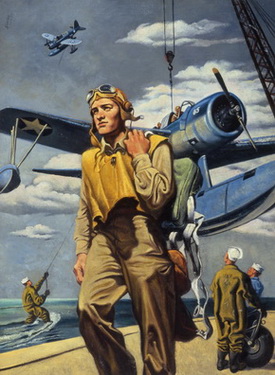This exhibit on Naval Aviation in World War II was put together by Abbott Laboratories in 1943 to tour the United States as part of their contribution to the war effort. This introduction was written for the original exhibition. The captions to the paintings, with minor alterations, were those originally written by the artists themselves.
The Navy takes great pride in the pictorial exhibit of Naval Aviation represented in this exhibition. Such a wartime record of its planes, its flyers and ground crews is an important historical contribution and a major accomplishment in enlightening the American people about this fast growing branch of the Navy.
The artists whose works compose the exhibit visited Naval Air Stations in every part of the country. They talked to the students and instructors, gained a thorough knowledge of Naval Aviation, and studied its training program. The tangible result of their laudable enterprise had been to provide us with a permanent tribute to the service. The paintings they have produced interpret the meaning of Naval Aviation with remarkable understanding.

The accuracy with which these paintings portray the most intimate details of training activities was not accomplished by chance. For weeks the artists lived at Naval Air Stations, were quartered with the men, making a conscientious effort to absorb Navy traditions and customs.
They covered all phases of the program, from Pre-Flight School up to combat. There are pictures of pilots, enlisted men, and Waves and of virtually all the Navy’s planes, both on the ground and in the air. To describe on canvas the actions they saw, the artists made numerous flights in all types of naval planes. The oils, watercolors, drawings and sketches which grew out of this research provide a spirited chronicle of the Navy in the air.
During a war, when military leaders are dedicating their full attention to a victory in the shortest possible time, it is sometimes difficult to inform the public adequately on many activities of the services, activities in which everyone has a vital interest. The actual battles, of course, are described from day to day correspondents and photographers in the war zones. Training activity, of necessity, does not receive this intense concentration. Although Naval Aviation has made a faithful attempt to report to the public the various ramifications of its training, voluntary contributions of talented and responsible civilians are received with gratitude.
It is with such a feeling that the Navy views this record of Naval Aviation in training. It is felt that these works by patriotic American artists are a worthy addition to the written and photographic record of the training program in wartime. They have caught the spirit of the men who fly and maintain the Navy’s planes. They have, in short, captured the essence of Naval Aviation.
J. T McCain, Vice Admiral,
U.S.N., Deputy Chief of Naval Operations (Air)